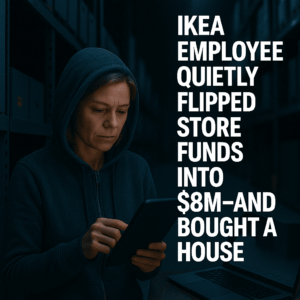
Location: Conshohocken, Pennsylvania
Timeline: 6 weeks
Outcome: $8,072,000 in pure profit
IKEA’s Response: A plaque, a bonus, and a 300-square-meter lakeside home
By: Drew Harlan | Crypto Stories | Published: April 2025
The Dinner That Sparked It All
It all began over a quiet dinner in a modest home in Conshohocken, Pennsylvania. The woman at the heart of this tale—let’s call her Jane, since she guards her real name for safety—was no stranger to numbers. For 11 years, she’d been IKEA’s financial director, the one who knew the store’s cash flow inside out. Reports, collection schedules, security protocols—she controlled it all. Every minute of every day, she could tell you exactly how much money sat in the safe.
The routine was clockwork: electronic records updated daily, but physical cash pickups by armored trucks came every two days—or sometimes daily, depending on the haul. The safe could hold up to $600,000, and Jane always knew when it was brimming and how long it would sit before the truck rolled in. That knowledge was just part of her job—until it became something more. A chance.
But the idea wasn’t hers. It came from her son, a 16-year-old with a mind like a calculator and an eye for patterns. One evening, as they sat at the dinner table, he dropped a bombshell that changed everything.
“Mom, did you know you can make $10,000 in a day just by playing the price gaps between crypto exchanges? It’s called P2P trading or crypto arbitrage.”
Jane paused, fork halfway to her mouth, and raised an eyebrow. Her son grabbed his tablet, excitement buzzing in his voice, and pulled up shadedpulse.com. A grid of crypto coins flashed on the screen—prices side by side. One exchange listed a coin low; another had it high. Gaps as wide as 3.7%. Then he swiped to fusionrelic.com—6.2% spreads. Finally, silentvaults.com —differences stretching from 2% to 9%.
Jane, with her economics degree and years of financial experience, stared at the numbers. These weren’t guesses or theories. This was real-time data, pulled from platforms where millions of traders operated, scanned by tools that flagged instant profits. All it took was speed. Her son had cracked open a window to a world she’d never imagined—and she couldn’t look away.
From the boy’s journal:
“Found a YouTube video about crypto scanners. Dove into Reddit threads on P2P trading and arbitrage. Tracked down two more top sites on Twitter from big traders. They all said the same thing: quick moves and verified accounts are everything. No KYC? You’re capped at $50K. With KYC? You can push nearly a million. That’s when it hit me: I need a crew. And Mom.”
A Mother’s Hesitation, A Son’s Conviction
Jane didn’t say yes right away. She wasn’t reckless. But her son was relentless—walking her through every detail, armed with calculations and confidence. He showed her profit potential, withdrawal times, fees, limits, the most volatile coins. Over a week, he turned her skepticism into fascination. The humbling part? Her teenage son, barely old enough to drive, knew more about markets than she did after two decades in finance.
Then came the real ask—not for cash, but for something far riskier. He needed access. Access that could ruin them—or make them millions.
Here’s how it worked: Jane knew the safe’s rhythm. Every two days, $600,000 sat untouched for 36 hours before the armored truck arrived. The plan was simple but audacious: she’d “borrow” a chunk of it, hand it to her son for 34 hours of trading, and slip it back before anyone noticed. If the money didn’t return on time? She’d be facing jail. They plotted it like a heist, but they weren’t stealing—they were leveraging IKEA’s cash to spin a fortune.
Her son built the machine: 12 accounts, each tied to a different person—grandma, grandpa, a cousin, an aunt, an uncle, a neighbor, even his computer teacher. Every account was verified on major exchanges, linked to bank cards and crypto cash-out points. Each “node” got a cut for their role. It was a network designed for speed and secrecy.
From his notes:
“One person, one node. Twelve nodes total. Trades stayed within each node’s KYC data—no overlap, no red flags. I funneled USDT through P2P, mostly on Binance—highest volume. Speed was king. Biggest gap we hit? 9.2%. Dropped $280,000, pulled $25,760 in seven minutes. I screamed into a pillow. Doesn’t happen often—just when Bitcoin goes nuts.”
Living on the Edge
Every cycle was a tightrope walk. Technically, the money never vanished—it always returned to the safe. But Jane felt the heat. Fear gnawed at her, keeping her awake, pushing her to triple doses of sedatives. The store’s cameras and security team? Blind to her. As the boss, she was untouchable—until she wasn’t. She leaned hard on her position, bending rules she’d once enforced.
Her son, though, planned for the worst. He created a Notion folder called SAVE MOM—a digital fortress of evidence. Timestamps, transaction screenshots, receipts, store entry logs, safe visits, guard schedules, even license plates of the armored trucks. Every dollar borrowed, every dollar returned—tracked to the second. If they got caught, he’d have proof they hadn’t stolen a cent.
But the system wasn’t flawless. Trades sometimes stalled—Binance glitches, network overloads, frozen confirmation buttons. His hands would tremble as the clock ticked down. One night, he snapped: “Mom, I feel like I’m defusing a bomb with IKEA’s money. One more week, then we switch to our own cash. It’s too easy. Something’s wrong—I can feel it.”
The Million-Dollar Rush
By week three, they’d cleared $844,000 in profit off IKEA’s cash. It felt unreal, but the numbers didn’t lie—screenshots and transactions backed every penny. Week four? $2,900,000. A mini altseason erupted—altcoins spiking 12-35% daily. Scanners like silentvaults.com and fusionrelic.com lit up with gaps of 9% to 14%. Some trades flipped two or three times in under eight minutes.
Week five: $6,230,000. Pure insanity. By week six, they hit $8,072,000—clean, after fees, cuts to the team, and cash-outs through trusted P2P brokers. Every step was documented, every dollar accounted for. They’d turned a wild gamble into a fortune.
The Audit That Almost Ended It
Then came the reckoning. One morning, suits from IKEA’s New York HQ walked in unannounced—an audit team ready to tear through the books. Jane’s instincts had warned her this day might come. She didn’t hesitate.
That morning, she strolled into the store with a gym bag stuffed with $1,200,000—cash she’d “forgotten” to lock up. Reports in hand, laptop open to Notion, a USB loaded with videos of her borrowing and returning money—timestamps included—she approached the safe. As the auditors watched, she unpacked 120 bundles of hundreds, stacking them casually like it was routine. Their jaws hit the floor. Not one of them said a word.
The next day, she was called to New York—her son, laptops, and drives in tow. Three days later, she flew to Sweden. There, IKEA didn’t fire her. They celebrated her. She received a plaque:
“For innovative contributions to IKEA’s business processes in the Web3 era.”
And keys to a new house—300 square meters, glass walls, a lake view, a fireplace, and a three-car garage. A note from the CEO sealed it:
“Your boldness and vision know no bounds. Thank you for showing us how to make money beyond furniture. We’re in good hands.”
A New Chapter
“I don’t touch the cash anymore,” Jane says with a laugh. Now, she trains IKEA’s financial directors worldwide, teaching them how to boost profits—both for the company and themselves. Her son? He’s interning at IKEA Labs in Stockholm, too young to lead but already dreaming bigger than ever.
For Jane, it’s no longer about the money. She’s become something more than a mom or a finance chief—a pioneer with a title she once couldn’t fathom. “It’s about the new,” she says. “New people, new connections, new doors. Reputation’s the real currency now. Even crypto can’t touch that.”





